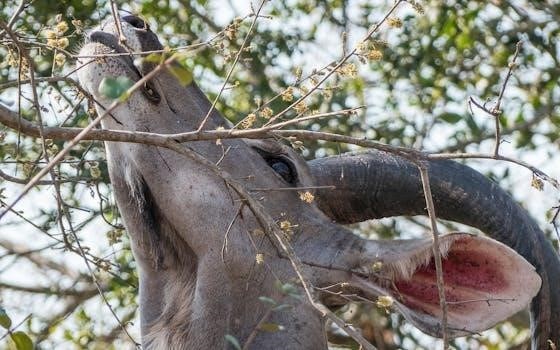Taste of the Wild Feeding Guide⁚ A Comprehensive Overview

Choosing the right dog food and understanding how much to feed is essential for your canine’s health. This guide will give you some feeding recommendations.
This comprehensive overview covers everything from nutritional needs to portion adjustments and special considerations for puppies.
This provides a starting point, but it’s essential to observe your dog’s body condition and adjust portions as needed.
Taste of the Wild dog food is a popular choice among pet owners seeking grain-free, high-protein diets for their canine companions. Inspired by ancestral diets, these recipes feature unique protein sources like bison, venison, and salmon, providing a taste of the wild that dogs instinctively crave. These formulas deliver not only a taste dogs love, but also nutrition.
The brand offers a diverse range of formulas tailored to different life stages and specific dietary needs. Whether you have a playful puppy, an active adult, or a senior dog with unique requirements, Taste of the Wild provides options designed to support their overall health and well-being.
Taste of the Wild meticulously outlines feeding recommendations based on your dog’s weight. These guidelines provide a starting point, but it’s essential to observe your dog’s body condition and adjust portions as needed.
The quality ingredients and carefully crafted recipes make Taste of the Wild a compelling option for pet owners. These recipes also are complete and balanced. This makes it a very good food for your pet.
Understanding Nutritional Needs
A balanced diet is paramount for a dog’s health, influencing everything from energy levels to coat quality. Understanding the specific nutritional needs of your dog, based on their life stage, breed, and activity level, is the first step in choosing the right food and establishing an appropriate feeding plan.
Protein is essential for muscle development and repair, while fats provide energy and support healthy skin and coat. Carbohydrates offer an additional energy source, and vitamins and minerals play a crucial role in various bodily functions. The amount listed in the feeding guide is the recommended total number of 8-ounce measuring cups that your pet should eat per day.
Puppies, with their rapid growth, require higher levels of protein and calcium to support bone and muscle development. Adult dogs need a balanced diet to maintain their weight and energy levels, while senior dogs may benefit from formulas with fewer calories and added joint support.
Active dogs need more calories and protein compared to their sedentary counterparts. Remember to keep fresh water available to your pet at all times. Taste of the Wild formulas are designed to meet these diverse needs, ensuring your dog receives the optimal nutrition they require.
Taste of the Wild Food Varieties
Taste of the Wild offers a diverse range of recipes designed to cater to different tastes and nutritional requirements. Each formula is crafted with unique protein sources, mirroring the ancestral diets of dogs. These recipes include options like High Prairie, Pacific Stream, Wetlands, and Sierra Mountain.

The High Prairie formula features roasted bison and venison, providing a rich source of protein and a distinctive flavor that many dogs adore. Pacific Stream includes smoked salmon, offering omega fatty acids that promote healthy skin and coat. The Wetlands recipe incorporates fowl, providing a balanced protein source with a unique taste.
Sierra Mountain utilizes lamb as its primary protein, which is easily digestible and ideal for dogs with sensitivities. Each variety is grain-free and supplemented with fruits, vegetables, and legumes. This provides essential vitamins, minerals, and antioxidants.
Taste of the Wild also offers puppy-specific formulas, such as High Prairie Puppy and Pacific Stream Puppy, tailored to meet the unique nutritional needs of growing dogs. These recipes ensure that puppies receive the necessary nutrients for optimal growth and development.
Selecting the right Taste of the Wild variety depends on your dog’s preferences, sensitivities, and life stage.
Feeding Guide Basics⁚ Weight and Age
Understanding the basics of a feeding guide is crucial for maintaining your dog’s health. Taste of the Wild provides feeding recommendations based on two primary factors⁚ weight and age. These guidelines offer a starting point for determining the appropriate daily food amount.
For adult dogs, the feeding guide typically lists a range of food quantities corresponding to different weight brackets. For example, a small dog weighing between 3 to 5 pounds might require 1/3 to 1/2 cup of food per day. Larger dogs, such as those weighing 40 to 60 pounds, may need 2 to 3 cups daily.
Age is another critical factor. Puppies have different nutritional needs than adult dogs, requiring more calories and nutrients to support their rapid growth. Taste of the Wild offers puppy-specific feeding guides that account for this. These guides usually provide amounts based on the puppy’s age in months, as well as their expected adult weight.
Remember, these are general guidelines. Individual dogs may require adjustments based on their metabolism, activity level, and overall health. Regularly monitoring your dog’s body condition is essential. You should be able to feel their ribs without excessive fat covering.
Adjust the amount of food accordingly to maintain a healthy weight. Always consult with your veterinarian.
Puppy Feeding Schedule
Establishing a consistent puppy feeding schedule is crucial for their growth and development. Puppies have smaller stomachs and higher energy needs than adult dogs, requiring more frequent meals throughout the day. A well-structured feeding schedule helps regulate their digestion and provides a steady stream of nutrients.
Generally, puppies under four months old should be fed three to four times a day. This frequency ensures they receive the necessary calories and nutrients without overloading their digestive system. As they grow, you can gradually reduce the number of meals.
Between four and six months, you can transition to feeding them two to three times a day. By six months, most puppies can be fed twice daily, similar to adult dogs. However, monitoring their body condition and adjusting the schedule as needed is essential.
Consistency is key. Try to feed your puppy at the same times each day to help regulate their metabolism and prevent overeating. A typical schedule might include meals at breakfast, lunch, and dinner for younger puppies, gradually reducing to breakfast and dinner as they mature.
Always provide fresh, clean water alongside their meals. The amount of food given at each feeding should align with the Taste of the Wild puppy feeding guidelines.
Adjusting Portions Based on Activity Level

A dog’s activity level significantly impacts their caloric needs, making it essential to adjust food portions accordingly. Highly active dogs require more calories to fuel their energy expenditure, while less active dogs need fewer calories to prevent weight gain. Monitoring your dog’s body condition and activity level is crucial for maintaining a healthy weight.
Active dogs, such as those involved in regular exercise, training, or working roles, benefit from increased food portions. These dogs burn more calories and need additional fuel to support their energy demands. Consider increasing their daily food intake by 20-50%, depending on the intensity and duration of their activity.
Conversely, less active or sedentary dogs require smaller portions to avoid obesity. Overfeeding can lead to weight gain and associated health problems. Reduce their daily food intake by 10-20% and closely monitor their weight and body condition.
Regularly assess your dog’s body condition by feeling their ribs; You should be able to feel their ribs without excessive fat covering. If you cannot easily feel their ribs, reduce their food portion.
Adjusting portions based on activity level ensures your dog receives the appropriate amount of calories to maintain a healthy weight and energy level. Always consult with your veterinarian for personalized feeding recommendations.
Special Considerations⁚ Pregnant or Nursing Dogs
Pregnancy and nursing place significant nutritional demands on female dogs, requiring adjustments to their feeding regimen to support both their health and the development of their puppies. During these periods, energy and nutrient requirements increase substantially, necessitating a higher food intake and a diet rich in essential nutrients.
During pregnancy, gradually increase the food portion starting from the fifth week, reaching a 25-50% increase by the end of gestation. This ensures the mother receives adequate calories and nutrients to support fetal growth. Feed smaller, more frequent meals to accommodate the expanding uterus and prevent discomfort.
Nursing dogs require even higher caloric intake to produce milk for their puppies. Increase their food portion by 2-3 times their normal amount, depending on the litter size and milk production. Provide free-choice feeding, allowing them to eat as much as they need to meet their energy demands.

Choose a high-quality puppy food, such as Taste of the Wild High Prairie Puppy, as it is formulated to meet the increased nutritional needs of pregnant and nursing dogs. Ensure the food is rich in protein, fat, and essential vitamins and minerals.
Monitor the dog’s body condition closely and adjust the food portion accordingly. Consult with your veterinarian for personalized feeding recommendations and to address any specific concerns during pregnancy and nursing.
Transitioning to Taste of the Wild
Switching your dog’s food to Taste of the Wild requires a gradual transition to avoid digestive upset. A sudden change in diet can lead to gastrointestinal issues such as diarrhea, vomiting, and loss of appetite. To ensure a smooth transition, it is recommended to mix the new food with the old food over a period of 7-10 days.
Start by mixing a small amount of Taste of the Wild (approximately 25%) with 75% of the old food. Over the next few days, gradually increase the proportion of Taste of the Wild while decreasing the amount of the old food. By the end of the transition period, your dog should be eating 100% Taste of the Wild.
Monitor your dog’s stool during the transition. If you notice any signs of digestive upset, such as loose stools or vomiting, slow down the transition process or consult with your veterinarian. Some dogs may be more sensitive to dietary changes than others, so it is important to adjust the transition schedule accordingly.
If your dog has a history of food sensitivities or allergies, it is especially important to transition slowly and carefully. Consider starting with a limited-ingredient formula, such as Taste of the Wild PREY, to minimize the risk of triggering an adverse reaction.
Always provide fresh water and monitor your dog’s overall health and behavior during the transition. If you have any concerns, consult with your veterinarian.
Addressing Potential Concerns
While Taste of the Wild is a popular and generally well-regarded dog food, some pet owners may have concerns about its ingredients or suitability for their dogs. One common concern is the inclusion of legumes, such as peas and lentils, which have been linked to a potential increased risk of dilated cardiomyopathy (DCM) in some dogs.
However, it’s important to note that the FDA has not established a causal relationship between diet, including Taste of the Wild, and DCM. If you are concerned about the potential risk of DCM, discuss it with your veterinarian. They can assess your dog’s individual risk factors and recommend appropriate monitoring or dietary changes.
Another potential concern is food sensitivities or allergies. If your dog has a history of food allergies, carefully review the ingredient list of Taste of the Wild formulas to identify any potential allergens. Consider trying a limited-ingredient formula or consulting with your veterinarian about allergy testing.
Some pet owners may also worry about the grain-free nature of Taste of the Wild. While grain-free diets can be beneficial for some dogs, they are not necessary for all dogs. If your dog tolerates grains well, there is no need to switch to a grain-free diet.
If you have any concerns about feeding Taste of the Wild to your dog, consult with your veterinarian. They can provide personalized advice based on your dog’s individual needs and health status.
Taste of the Wild Feeding Guidelines
Taste of the Wild provides feeding guidelines on their packaging and website, offering a starting point for determining how much food your dog needs daily; These guidelines are based on your dog’s weight, age, and activity level. However, it’s essential to remember that these are just recommendations, and individual needs may vary.
Start by consulting the feeding chart on the Taste of the Wild product you’re using. Find your dog’s weight range and note the corresponding daily food amount. This amount is typically expressed in cups, using a standard 8-ounce measuring cup.
Divide the total daily amount into multiple meals, typically two or three, depending on your dog’s age and preferences. Puppies, for example, often benefit from more frequent, smaller meals.
Monitor your dog’s body condition closely. You should be able to feel their ribs easily without excessive fat covering them. If your dog is gaining too much weight, reduce the daily food amount. If they’re losing weight or seem hungry, increase the amount slightly.
Adjust the feeding amount based on your dog’s activity level. Active dogs need more calories than less active dogs. Consider factors such as exercise, play, and overall energy levels when making adjustments.
Remember to provide fresh, clean water at all times. Water is essential for digestion, nutrient absorption, and overall health.
